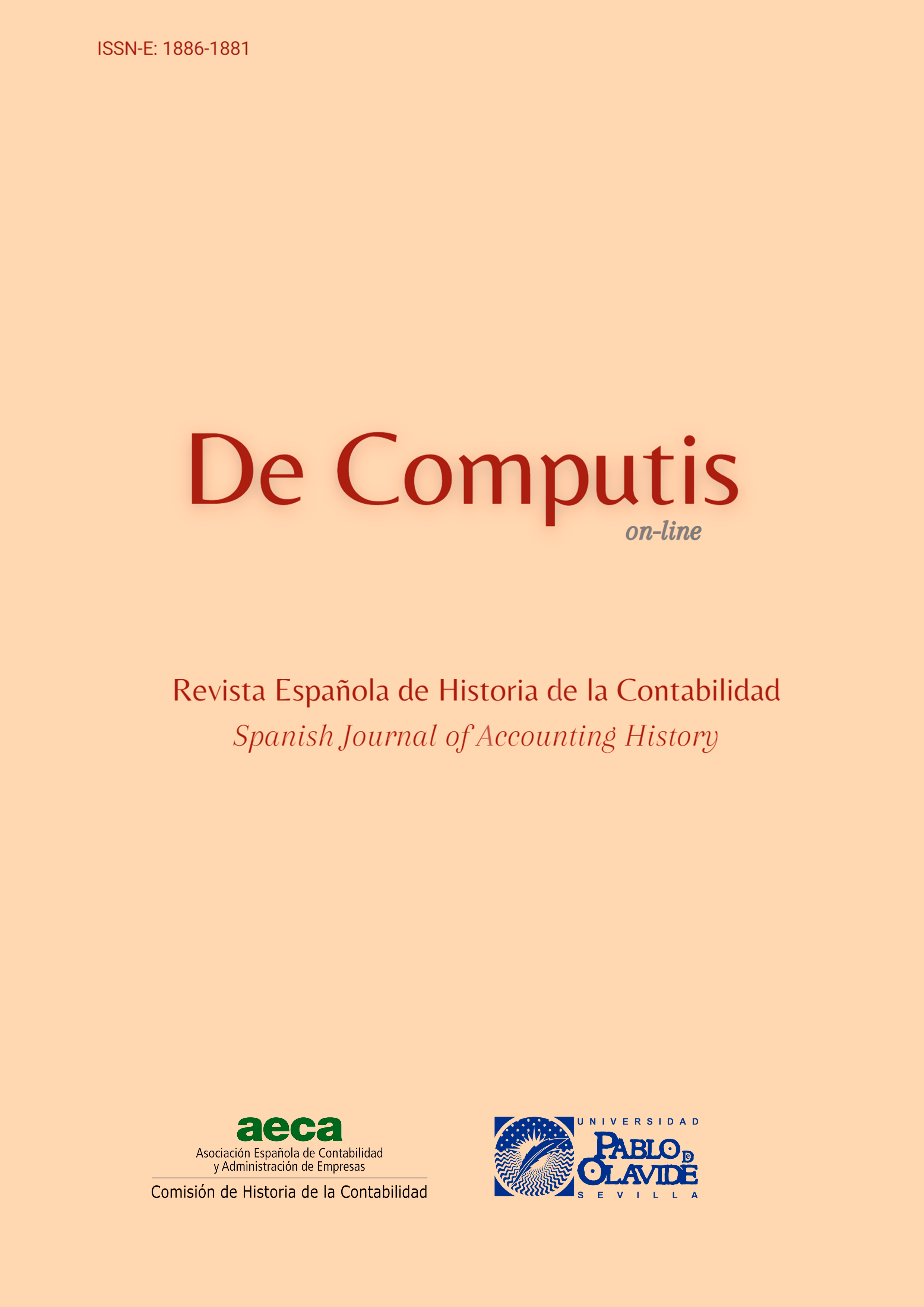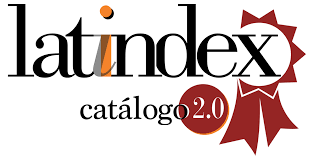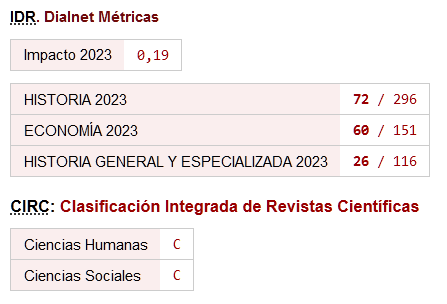Genoa 1340, Double Entry, and ‘Gold Coasting’
DOI:
https://doi.org/10.26784/issn.1886-1881.22.1.11927Palabras clave:
Accounting history, medieval, bookkeeping, double entry, Genova, MassariResumen
The objective of this study is to contribute to the existing literature on the history of accounting by expanding the knowledge of one of the most famous government account books from the medieval period kept using the double entry method. In doing so, particular attention is paid to the influence of political and religious factors on the organisation of accounting and the peculiarities of the accounting for merchandise trading. The result of a detailed study of the Cartullarium Massariorum ledger of the Commune of Genoa for 1340, carried out using logical-analytical modelling, is presented. That modelling method was developed for the study of medieval accounting systems. Peculiarities in the organisation of the accounting and taxation of the Commune are presented along with analyses the budget revenues and expenditures. Particular attention is paid to the accounting for goods and the apparently regular practice by the Commune of Genoa of the sale of goods at a loss.
Descargas
Citas
Aprosio, S. (2001). Vocabolario ligure storico-bibliografico: Latino. v. 1. AL. v. 2. MX (Vol. 1). M. Sabatelli.
Aquinas, T. (1271) 2020. “Thomas Aquinas: Commentary on Aristotle’s Nicomachean Ethics (c. 1271).” Translated by C. I. Litzinger. In A
Source Book on Early Monetary Thought: Writings on Money before Adam Smith, edited by E. W. Fuller, 29–33. Northampton, Mass.:
Edward Elgar. Original-language essay written c. 1271.
Aquinas, T. (1265-1274) 1897. Summa Theologiae, ed. Leonina, n°9, Roma: Typographia poliglotta S. C. de Propaganda Fide.
Bagliano, C. (1911). Sulla contabilità di Stato in Genova: ricerche. Roma: Tip. cooperativa.
Besta, F. (1922). La ragioneria: Ragioneria generale. v. 1-2 (Vol. 1). Vallardi.
Brambilla G. (1901). Storia della ragioneria italiana, Milano: Stabilimento Tipografico Attilio Boriglione.
Carmona Moreno, S. N., Ezzamel, M., & Gutiérrez Hidalgo, F. (2004). Accounting history research: traditional and new accounting history perspectives. De Computis, Revista Española de Historia de la Contabilidad, 1(1), 24-53. https://doi.org/10.26784/issn.1886-1881.v1i1.239.
Chursina, S. A. (1977). Trade in cloth in Genoa in the 13th-early 14th c. Antiquity and the Middle Ages. Vol. 14., 109-122.
Cipolla, C. M. (1967). Money, prices, and civilization in the Mediterranean world: fifth to seventeenth century. Gordian press, INC. New York.
Cordery, C., Gomes, D., Leoni, G., McBride, K., & Napier, C. (2023). Innovation in accounting historiography: Where to from here? Accounting History, 28(3), 368-389. https://doi.org/10.1177/10323732231168457.
Dante, A. and Longfellow, H. W. (1904), The Divine Comedy of Dante Alighieri. Boston ; New York: Houghton Mifflin.
De Roover, R. (1956). The development of accounting prior to Luca Pacioli according to the account-books of Medieval merchants. Littleton А.С., Yamey B.S. Studies in the History of Accounting. London: Sweet & Maxwell. 114–174.
Desimoni, C. (1889). Cristoforo Colombo e il Banco di San Giorgio – Studio di Henry Harisse. Atti della Societa'Ligure di Storia Patria, XIX, Fasc, 3. Genova: Tip. del R. Istituto sordo-muti.
Dobie, A. (2016). ‘The ‘medieval’, the common good and accounting’. in K Akrivou & AJG Sison (eds), The Challenges of Capitalism for Virtue Ethics and the Common Good: Interdisciplinary Perspectives. Edward Elgar, Cheltenham, Gloucestershire, (pp. 37-48). https://doi.org/10.4337/9781784717919.00009.
Einaudi, L. (1953). “The theory of imaginary money from Charlemagne to the French Revolution”. In Lane, F.C. & Riemersma, J.C. (Eds.). Enterprise and secular change. London: George Allen & Unwin Ltd, 229-261.
Epstein, S. (1996). Genoa and the Genoese, 958-1528. Chapill Hill, Lindon: University of North Carolina Press.
Giaro, T. (2021). Medieval Canon Lawyers and European Legal Tradition. A Brief Overview. Review of European and Comparative Law, 157-187. https://doi.org/10.31743/recl.12727.
Gioffrè, D. (1967). Il debito pubblico genovese: Inventario delle compere anteriori a San Giorgio o non consolidate nel Banco (Sec. XIV-XIX) (Vol. 1). Milano: A. Giuffrè.
Goldthwaite, R. & Mandich, G. (1994). Studi sulla moneta fiorentina (secoli XIII-XVI). Leo S. Olschki.
Gomes, D., Carnegie, G. D., Napier, C. J., Parker, L. D., & West, B. (2011). Does accounting history matter? Accounting History, 16(4), 389-402. https://doi.org/10.1177/1032373211417993.
Greif, A. (1994). On the political foundations of the late medieval commercial revolution: Genoa during the twelfth and thirteenth centuries. The Journal of Economic History, 54(2), 271-287. https://doi.org/10.1017/S0022050700014479.
Gurskaya, M. (2022). The development of double entry bookkeeping in the XIII-XV (Doctoral dissertation, Saint-Peterburg State University).
Felloni, G. (1984). Struttura e movimenti dell'economia genovese tra Due e Trecento: Bilanci e prospettive di ricerca. In Atti della Società Ligure di Storia Patria, nuova serie, XXIV/2: 151-177.
Ten Have, O. (1956). Simon Stevin of Bruges. In A. C. Littleton, & B. S. Yamey (Eds.), Studies in the history of accounting (pp. 236-246). London: Sweet and Maxwell Limited.
Hernández Esteve, E. (1992). Propuestas de contabilidad por partida doble para llevar las cuentas centrales de la Real Hacienda Castellana (Hacia 1574). Técnica Contable, XLIV, 535-554, 649-664
Hyde, J. K. (1973). The emergence of the communes. In Society and Politics in Medieval Italy: The Evolution of the Civil Life, 1000–1350 (pp. 38-64). London: Macmillan Education UK. https://doi.org/10.1007/978-1-349-15504-0_3
Januard, P. (2021). Analysis risk and commercial risk: the first treatment of usury in Thomas Aquinas’s Commentary on the Sentences. The European Journal of the History of Economic Thought, 28(4), 599-634. https://doi.org/10.1080/09672567.2020.1861046.
Kuter, M. I., Gurskaya, M. M., & Sidiropulo, O. A. (2013). The Genoese commune massari's ledger of 1340: The First computer modeling experience and its results. Journal of modern accounting and auditing, 9(2), 212-229.
Kuter, M., Gurskaya, M., Andreenkova, A., & Musaelyan, A. (2018). The virtual reconstruction of the earliest double entry accounting ledger. In Information Technology Science (pp. 169-184). Springer International Publishing. DOI https://doi.org/10.1007/978-3-319-74980-8_16
Kuter, M., Baker, C. R., Gurskaya, M., & Sagitova, R. (2024). Peculiarities of accounting practices in Francesco Datini’s partnership in Pisa. Accounting Historians Journal, 51(1), 39-61. https://doi.org/10.2308/AAHJ-2021-024
Lanfranchi, G. (1891). Le origini della partita doppia secondo le piu'recenti indagini. Tip. sociale.
Lee, G. A. (1973a). The Florentine bank ledger fragments of 1211: Some new insights. Journal of Accounting research, 47-61. https://doi.org/10.2307/2490281
Lee, G. A. (1973b). The development of Italian bookkeeping 1211-1300. Abacus, 9(2), 137-155. https://doi.org/10.1111/j.1467-6281.1973.tb00183.x
Lee, G. A. (1977). The coming of age of double entry: the Giovanni Farolfi ledger of 1299-1300. The Accounting Historians Journal, 79-95. https://doi.org/10.2308/0148-4184.4.2.79
Lizzul, G., Poole, K., & Sutherland, S. (2022). Public Debt in Renaissance Italy. Routledge. DOI: https://doi.org/10.4324/9780367347093-RERW96-1.
Manke, J. (2019). Granum Bonum: Grain Distribution and the Emergence of Popular Institutions in Medieval Genoa. Ph.D dissertation, University of Minnesota, https://hdl.handle.net/11299/211779
Martinelli, A. (1974) The Origination and evolution of double entry bookkeeping to 1440. ProQuest Dissertations & Theses Global pg. n/a.
Martinelli, A. (1983). The ledger of Cristianus Lomellinus and Dominicus De Garibaldo, stewards of the city of Genoa (1340–41). Abacus, 19(2), 83-118. https://doi.org/10.1111/j.1467-6281.1983.tb00242.x
Martínez Ruiz, J. I. (1988). La reforma de la Contaduria Municipal de Sevilha y la introduccion del Libro de Caja (1567). Revista Española de Financiación y Contabilidad, XVII(56), 335-349.
Melis, F. (1950). Storia della Ragioneria. Bologna: Dott. Cesare Zuffi Editore.
Melis, F. (1964). ‘Discussion’, in Finance et Comptabilit´e Urbaines du XIIIe au XVIe Si`ecle (Actes, Colloque Internationale, 1962), n.p.: Pro Civitate, p. 376
Mills, G. T. (1994). Early accounting in northern Italy: the role of commercial development and the printing press in the expansion of double entry from Genoa, Florence and Venice. Accounting Historians Journal, 21(1), 81-96. DOI: https://doi.org/10.2308/0148-4184.21.1.81.
Miner, J. (2020). Profit and Patrimony: Property, Markets, and Public Debt in Late Medieval Genoa. Business History Review, 94(1), 73-94. DOI: https://doi.org/10.1017/S0007680519001211.
Munro, J. H. (2003). The medieval origins of the financial revolution: usury, rentes, and negotiability. The international history review, 25(3), 505-562. https://doi.org/10.1080/07075332.2003.9641005.
Orlandi, A. (2021). The emergence of double entry bookkeeping in Tuscan firms of the thirteenth and fourteenth centuries. Accounting History, 26(4), 534-551. https://doi.org/10.1177/10323732211032298.
Pegolotti, F. B., & Evans, A. (1936). La pratica della mercatura. The Medieval Academy of America. Cambridge, Massachusetts.
Penndorf, B. (1929). Luka Pacioli – Aus seinem Leben. Zeitschrift fur Handelswissencchaft und Handelspraxis.
Polonio, V. (1977). L'amministrazione della res publica genovese fra Tre e Quattrocento. L'archivio" Antico Comune".
Reynolds, R. L., (1951). Banker’s account in double entry in Genoa, 1313 and 1316, Bollettino ligustico, III, 33-37.
Salonia, M. (2015). Genoese economic culture: from the Mediterranean into the Spanish Atlantic (Doctoral dissertation, University of Liverpool). DOI: https://doi.org/10.1017/CBO9781316459362.002.
Sangster, A. (2016). The genesis of double entry bookkeeping. The Accounting Review, 91(1), 299-315. https://doi.org/10.2308/accr-51115.
Sangster, A. (2024). The emergence of double entry bookkeeping. The Economic History Review. DOI: https://doi.org/10.1111/ehr.13358.
Sieveking, H. (1898). Genueser Finanzwesen mit besonderer Berücksichtigung der Casa di S. Giorgio (Vol. 1). Leipzig und Tübingen: JCB Mohr.
Sieveking, H. (1905). Studio sulle finanze genovesi nel Medio Evo ed in particolare sulla Casa di S. Giorgio in Atti della Società Ligure di Storia patria, XXXV'parts I and II. Genova: Tipografia della Gioventù
Tafur, P. (1874). Andanças é viajes de Pero Tafur por diversas partes del mundo avidos:(1435-1439.) (Vol. 8). Madrid: Ginesta.
Walsh, A. (2024). Usury in Medieval Christianity. In The Palgrave Handbook of Philosophy and Money: Volume 1: Ancient and Medieval Thought (pp. 595-615). Cham: Springer International Publishing. DOI: https://doi.org/10.1007/978-3-031-54136-0_31.
Yamey, B. S. (2000). The ‘particular gain or loss upon each article we deal in’: an aspect of mercantile accounting, 1300-1800. Accounting, Business & Financial History, 10(1), 1-12. DOI: https://doi.org/10.1080/095852000330168.
Yamey, B. S. (2012). Personal accounts, account books and their probative value: Historical notes, c. 1200 to c. 1800. Accounting Historians Journal, 39(2), 1-26. DOI: https://doi.org/10.2308/0148-4184.39.2.1.
Zambon, S. (2000). Setting the context for the modern accounting profession: audit, accountability and the College of Rasonati in the Venetian Republic (XIII-XVI century). Accounting and history: a selection of papers presented at the 8th World Congress of Accounting Historians (pp. 351-384). Madrid: AECA.
Zerbi, T. (1952). Le origini della partita doppia: gestioni aziendali e situazioni di marcato nei secoli XIV e XV. C. Marzorati.
Descargas
Publicado
Cómo citar
Número
Sección
Licencia
Derechos de autor 2025 Mikhail Kuter , Marina Gurskaya, Albert Gurskii

Esta obra está bajo una licencia internacional Creative Commons Atribución-NoComercial-CompartirIgual 4.0.










